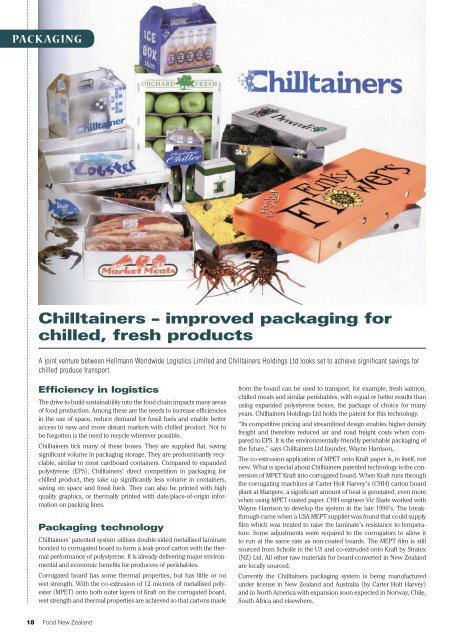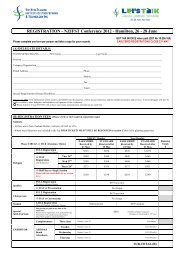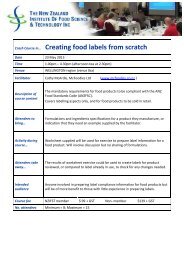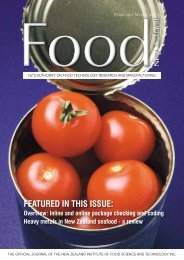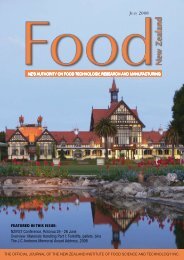featured in this issue - NZIFST - The New Zealand Institute of Food ...
featured in this issue - NZIFST - The New Zealand Institute of Food ...
featured in this issue - NZIFST - The New Zealand Institute of Food ...
You also want an ePaper? Increase the reach of your titles
YUMPU automatically turns print PDFs into web optimized ePapers that Google loves.
PACKAGING<br />
Chillta<strong>in</strong>ers – improved packag<strong>in</strong>g for<br />
chilled, fresh products<br />
A jo<strong>in</strong>t venture between Hellmann Worldwide Logistics Limited and Chillta<strong>in</strong>ers Hold<strong>in</strong>gs Ltd looks set to achieve significant sav<strong>in</strong>gs for<br />
chilled produce transport.<br />
Efficiency <strong>in</strong> logistics<br />
<strong>The</strong> drive to build susta<strong>in</strong>ability <strong>in</strong>to the food cha<strong>in</strong> impacts many areas<br />
<strong>of</strong> food production. Among these are the needs to <strong>in</strong>crease efficiencies<br />
<strong>in</strong> the use <strong>of</strong> space, reduce demand for fossil fuels and enable better<br />
access to new and more distant markets with chilled product. Not to<br />
be forgotten is the need to recycle wherever possible.<br />
Chillta<strong>in</strong>ers tick many <strong>of</strong> these boxes. <strong>The</strong>y are supplied flat, sav<strong>in</strong>g<br />
significant volume <strong>in</strong> packag<strong>in</strong>g storage. <strong>The</strong>y are predom<strong>in</strong>antly recyclable,<br />
similar to most cardboard conta<strong>in</strong>ers. Compared to expanded<br />
polystyrene (EPS), Chillta<strong>in</strong>ers’ direct competition <strong>in</strong> packag<strong>in</strong>g for<br />
chilled product, they take up significantly less volume <strong>in</strong> conta<strong>in</strong>ers,<br />
sav<strong>in</strong>g on space and fossil fuels. <strong>The</strong>y can also be pr<strong>in</strong>ted with high<br />
quality graphics, or thermally pr<strong>in</strong>ted with date/place-<strong>of</strong>-orig<strong>in</strong> <strong>in</strong>formation<br />
on pack<strong>in</strong>g l<strong>in</strong>es.<br />
Packag<strong>in</strong>g technology<br />
Chillta<strong>in</strong>ers’ patented system utilises double-sided metallised lam<strong>in</strong>ate<br />
bonded to corrugated board to form a leak-pro<strong>of</strong> carton with the thermal<br />
performance <strong>of</strong> polystyrene. It is already deliver<strong>in</strong>g major environmental<br />
and economic benefits for producers <strong>of</strong> perishables.<br />
Corrugated board has some thermal properties, but has little or no<br />
wet strength. With the co-extrusion <strong>of</strong> 12 microns <strong>of</strong> metallised polyester<br />
(MPET) onto both outer layers <strong>of</strong> Kraft on the corrugated board,<br />
wet strength and thermal properties are achieved so that cartons made<br />
from the board can be used to transport, for example, fresh salmon,<br />
chilled meats and similar perishables, with equal or better results than<br />
us<strong>in</strong>g expanded polystyrene boxes, the package <strong>of</strong> choice for many<br />
years. Chillta<strong>in</strong>ers Hold<strong>in</strong>gs Ltd holds the patent for <strong>this</strong> technology.<br />
“Its competitive pric<strong>in</strong>g and streaml<strong>in</strong>ed design enables higher density<br />
freight and therefore reduced air and road freight costs when compared<br />
to EPS. It is the environmentally-friendly perishable packag<strong>in</strong>g <strong>of</strong><br />
the future,” says Chillta<strong>in</strong>ers Ltd founder, Wayne Harrison,.<br />
<strong>The</strong> co-extrusion application <strong>of</strong> MPET onto Kraft paper is, <strong>in</strong> itself, not<br />
new. What is special about Chillta<strong>in</strong>ers patented technology is the conversion<br />
<strong>of</strong> MPET Kraft <strong>in</strong>to corrugated board. When Kraft runs through<br />
the corrugat<strong>in</strong>g mach<strong>in</strong>es at Carter Holt Harvey’s (CHH) carton board<br />
plant at Mangere, a significant amount <strong>of</strong> heat is generated, even more<br />
when us<strong>in</strong>g MPET coated paper. CHH eng<strong>in</strong>eer Vic Slade worked with<br />
Wayne Harrison to develop the system <strong>in</strong> the late 1990’s. <strong>The</strong> breakthrough<br />
came when a USA MEPT supplier was found that could supply<br />
film which was treated to raise the lam<strong>in</strong>ate’s resistance to temperature.<br />
Some adjustments were required to the corrugators to allow it<br />
to run at the same rate as non-coated boards. <strong>The</strong> MEPT film is still<br />
sourced from Scholle <strong>in</strong> the US and co-extruded onto Kraft by Stratex<br />
(NZ) Ltd. All other raw materials for board converted <strong>in</strong> <strong>New</strong> <strong>Zealand</strong><br />
are locally sourced.<br />
Currently the Chillta<strong>in</strong>ers packag<strong>in</strong>g system is be<strong>in</strong>g manufactured<br />
under license <strong>in</strong> <strong>New</strong> <strong>Zealand</strong> and Australia (by Carter Holt Harvey)<br />
and <strong>in</strong> North America with expansion soon expected <strong>in</strong> Norway, Chile,<br />
South Africa and elsewhere.<br />
18<br />
<strong>Food</strong> <strong>New</strong> <strong>Zealand</strong>


